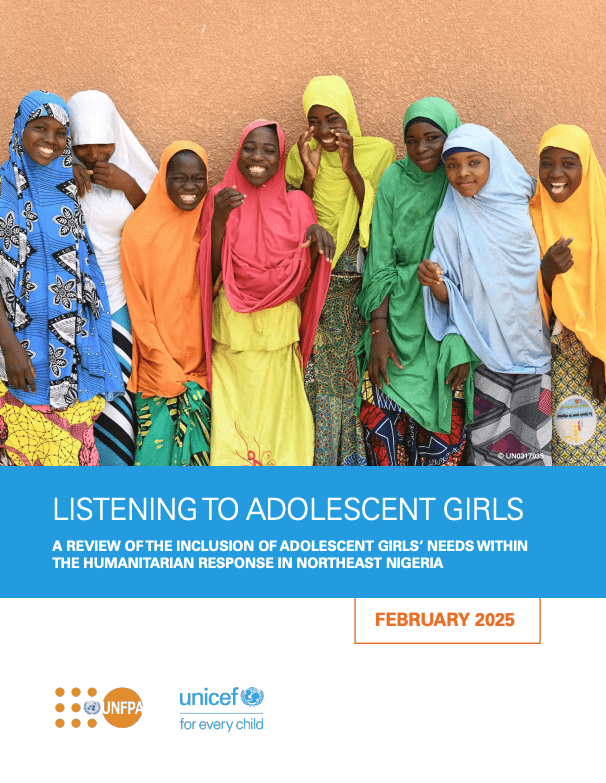
Publication
Listening to Adolescent Girls: A Review of the Inclusion of Adolescent Girls’ Needs within the Humanitarian Response in Northeast Nigeria
Number of pages: 52
Publication date: 13 May 2025
Publisher: UNICEF and UNFPA

Publication
Number of pages: 52
Publication date: 13 May 2025
Publisher: UNICEF and UNFPA
The document titled "A Review of the Inclusion of Adolescent Girls’ Needs within the Humanitarian Response in Northeast Nigeria" is the result of a review of the interagency humanitarian response and analyses how the multi-sector needs of adolescent girls are addressed within humanitarian efforts responding to the crisis in Northeast Nigeria. The review was carried out using a participatory approach that included adolescent girls as well as multiple local and women-led organizations.
Context and Purpose
The Borno, Adamawa, and Yobe (BAY) States of northeast Nigeria have been acutely affected by conflict, disaster, displacement, and insecurity. Adolescent girls are historically overlooked in humanitarian responses and rarely have opportunity to participate in needs assessment and monitoring efforts. This review was the first of its kind and looked at the gaps in the humanitarian response, identified promising practices and evidence-based programming that should be scaled up, and identified actions for all stakeholders in the humanitarian system to take to ensure adolescent girls’ needs are identified and met in northeast Nigeria and other humanitarian contexts.
Methodology
The review synthesizes data from a desk review of available literature, key informant interviews, and focus group discussions with adolescent girls (and their caregivers when appropriate). It was undertaken with a participatory approach along with intersectional and survivor-centred approaches and draws from the to form a holistic picture of existing gaps and opportunities.
Key Findings
Adolescent girls are often not distinctly recognized in needs assessments or program designs. Data tends to aggregate "children" or "women and girls," erasing the specific realities of this age group. As a result, programming rarely targets or adapts to the needs of girls aged 10–19.
Harmful social norms, gender inequality and discrimination, and safety concerns significantly limit girls' access to essential services such as education, healthcare, nutrition, psychosocial support, and protection. Mobility restrictions, lack of availability of accurate information and age-appropriate services for sexual and reproductive health (SRH), and lack of pathways to suitable livelihoods further compound the challenges.
Adolescent girls face high risks of sexual violence, exploitation, and early marriage—risks exacerbated by displacement and weakened protective structures. Many girls lack safe spaces or confidential reporting mechanisms, which reduces their ability to seek help, and are living in fear of abduction from non-State armed groups.
Humanitarian organizations do not consistently provide opportunities for adolescent girls to meaningfully participate in needs assessments, monitoring, or feedback systems, which excludes adolescent girls from decision-making spaces. Girls’ voices are seldom included in community consultations or program design, leaving interventions less relevant or effective for them.
Promising practices were identified during the review, such as the establishment of community-based safe spaces for adolescent girls where they can receive accurate information about their rights and available services as well as receive referrals in the case of violence. In addition, some sectors made changes to their programing upon receipt of feedback from adolescent girls though this was ad hoc and not systematic. Notably, the country-based pooled fund had a dedicated funding window for programming that addressed the needs of women and girls and prioritized funding to local organizations.
Recommendations
The review calls for a strategic shift in humanitarian responses to ensure adolescent girls are prioritized and have opportunities to participate. Key recommendations include:
Conclusion
The review concludes that while there is growing recognition of the unique challenges faced by adolescent girls, this has not yet consistently translated into programming in northeast Nigeria. Greater funding, inclusive planning and assessments, and shifts in harmful social norms are needed to ensure that humanitarian responses are equitable and truly responsive to all—especially those who are most vulnerable to exclusion and protection violations.